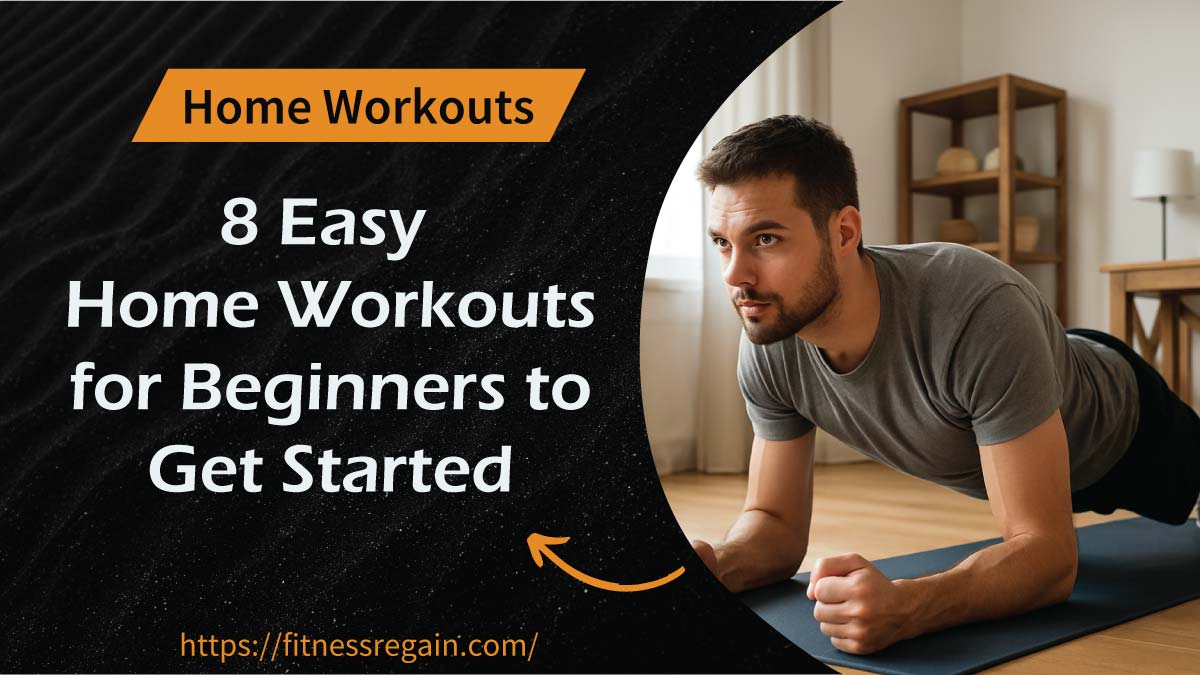Starting a fitness routine can be a challenge, especially if you’re new to working out or if gyms feel intimidating or inconvenient. I completely get it. When I first decided to get in shape, I didn’t have fancy equipment, and the thought of complex workouts overwhelmed me. That’s why easy home workouts for beginners are such a fantastic way to build strength, burn fat, and boost your energy — all on your own schedule and in your own space.
The beauty of home workouts is you don’t need expensive machines or a gym membership. All it takes is some motivation, a bit of space, and a handful of effective, beginner-friendly exercises that can be done with little or no equipment. I’m going to share eight simple workouts you can start today — backed by my own experience and tips to keep you consistent.
👉 For a complete expert-backed approach to staying fit at home, don’t miss our Ultimate Guide to the Best Easy At Home Workout Routines—a trusted resource designed to help all fitness levels build effective, sustainable routines.
1. March in Place – Your Simple, Energizing Warm-Up
Before jumping into anything too intense, warming up is key. It gets your blood pumping and prepares your muscles and joints for movement.
How to do it:
-
Stand tall with feet hip-width apart.
-
March in place, lifting your knees as high as comfortable.
-
Swing your arms naturally.
-
Keep a steady pace for 3 to 5 minutes.
Why this works:
This low-impact cardio boosts your heart rate gently without stressing your joints, making it perfect for beginners or anyone recovering from injury. It also helps combat that sluggish feeling — I often do this right after waking up or before starting chores around the house.
Pro tip: Try to do this warm-up before any workout, even if it’s just a few minutes. It’s an easy habit that prepares your body for success.
2. Wall Push-Ups – Build Upper Body Strength with Confidence
Regular push-ups can be intimidating when you’re just starting. Wall push-ups are a great alternative that work your chest, shoulders, and arms — without requiring you to support your full body weight.
How to do it:
-
Stand facing a wall about arm’s length away.
-
Place your palms flat on the wall at shoulder height and width.
-
Slowly bend your elbows, bringing your chest toward the wall.
-
Push back to the starting position.
-
Perform 12 to 15 reps, rest, then repeat 2 to 3 sets.
My experience:
When I first started strength training, wall push-ups gave me the confidence to build upper body strength without straining. They helped me progress towards traditional push-ups over time.
3. Chair Squats – Activate Your Legs and Glutes Safely
Squats are one of the most functional exercises — helping with everyday movements like standing up or climbing stairs. Using a chair for support helps beginners perfect form and avoid injury.
How to do it:
-
Stand in front of a sturdy chair with feet shoulder-width apart.
-
Slowly lower your body toward the chair as if sitting down.
-
Lightly tap the chair with your glutes without fully sitting.
-
Press through your heels to stand back up.
-
Aim for 10 to 15 reps, completing 2 to 3 sets.
Why this matters:
Building leg and glute strength improves balance and mobility, especially as we age. I found that chair squats gave me stability and strength in my lower body before I tried deeper squats.
4. Standing Bicycle Crunches – Core Workout Without the Floor
Floor exercises can be uncomfortable for some beginners, so standing bicycle crunches are a perfect alternative to engage your core and improve coordination.
How to do it:
-
Stand tall with feet hip-width apart.
-
Place hands lightly behind your head.
-
Bring your right knee up and twist your torso, touching your left elbow to your right knee.
-
Alternate sides in a controlled, steady pace.
-
Do 15 reps on each side for 2 sets.
Benefits:
This move not only tones your abs but also works your obliques and improves balance. I use this as part of my daily routine when I want a quick core booster.
5. Step Touches – Low-Impact Cardio That’s Actually Fun
Step touches feel like dancing, and that’s why I love them. It’s an easy way to get your heart pumping, especially if jumping or running isn’t your thing.
How to do it:
-
Step your right foot to the side.
-
Bring your left foot to meet your right.
-
Repeat stepping left and then right.
-
Add arm movements or clap to increase intensity.
-
Continue for 1 to 3 minutes or more.
Why it works:
Step touches are great for beginners and seniors alike, providing a low-impact cardio workout that burns calories and improves heart health without joint strain. Plus, it’s easy to fit into any part of your day.
6. Bird-Dog – Improve Core Strength and Balance
This exercise targets the core and lower back muscles, helping prevent back pain and improve posture.
How to do it:
-
Start on your hands and knees (tabletop position).
-
Extend your right arm forward and your left leg back simultaneously.
-
Hold for 2-3 seconds while engaging your core.
-
Return to start and repeat with the opposite arm and leg.
-
Aim for 10 to 12 reps on each side.
My personal insight:
After long hours sitting at a desk, the bird-dog helped me feel steadier and reduced stiffness in my back. It’s a perfect low-impact move for beginners to build core stability safely.
7. Glute Bridges – Strengthen Your Lower Body and Core
Sitting for long periods weakens your glutes, which can affect posture and cause lower back issues. Glute bridges activate these important muscles.
How to do it:
-
Lie on your back with knees bent and feet flat on the floor, hip-width apart.
-
Press through your heels to lift your hips toward the ceiling.
-
Squeeze your glutes at the top and hold for 2 seconds.
-
Slowly lower back down.
-
Perform 12 to 15 reps, 2 to 3 sets.
Why I love this move:
It’s a simple exercise that you can do anywhere. I felt stronger and more stable after adding glute bridges to my routine, especially when standing or walking.
8. Cool Down and Stretch – The Essential Final Step
After your workout, taking a few minutes to stretch helps your muscles recover, reduces soreness, and improves flexibility.
Try this routine:
-
Forward fold: Reach toward your toes, hold for 30 seconds.
-
Seated hamstring stretch: Sit and reach for your toes on each leg, 30 seconds each.
-
Shoulder rolls: 10 rolls forward and 10 backward.
-
Deep breathing: Sit comfortably and breathe deeply for 1 minute.
Why it matters:
Skipping cooldown stretches was one mistake I made early on — it led to stiffness and slowed progress. Now, I make it a priority, and my body thanks me for it.
How to Make These Workouts Part of Your Life — My Best Tips
Consistency is everything in fitness. Here’s what helped me stick with my home workouts:
1. Set Realistic Goals
Start with 10-15 minutes a day, 3-4 times per week. As you build strength and stamina, increase duration and reps gradually.
2. Create a Dedicated Space
Even a small corner with a yoga mat or towel can be your workout zone. Having a spot ready makes it easier to stay consistent.
3. Track Your Progress
Keep a simple journal or use a phone app to record workouts, reps, and how you feel. Seeing improvements is incredibly motivating!
4. Find Accountability
Whether it’s a friend, family member, or online community, sharing your fitness journey can keep you motivated.
5. Mix It Up
Use these 8 workouts as a base. As you get stronger, add new moves or increase intensity to keep things fresh.
Why Home Workouts Are a Game-Changer for Beginners
Working out at home removes barriers like travel time, membership fees, or gym intimidation. You get to control your pace and schedule.
From my own journey, I learned that even short, consistent sessions at home deliver real results — increased energy, better mood, and improved strength.
For anyone starting out, these easy home workouts are the best way to build confidence, stay safe, and enjoy movement.
Ready to Take Action? Your Fitness Journey Starts Now
There’s no perfect time to start — only the present moment. Whether you choose to begin with a warm-up march, chair squats, or glute bridges, taking that first step is the most important.
Remember, fitness isn’t about perfection; it’s about progress. Celebrate every small victory, listen to your body, and most importantly, have fun!
If you found this guide helpful, I’d love to hear from you! Comment below with your favorite workout, share your progress, or tag a friend who needs easy, beginner-friendly workouts.
Here’s to your health, strength, and happiness — right from the comfort of home!
Also Read:
FAQs
How often should beginners do home workouts?
Beginners should aim for 3 to 4 workout sessions each week, lasting around 20 to 30 minutes. It’s more important to be consistent than to push too hard at first. Starting with manageable routines helps your body adjust and reduces the risk of burnout or injury. Over time, you can increase frequency and intensity as your strength and endurance improve, building a lasting fitness habit.
Do I need any special equipment to start these workouts?
No special equipment is required for these beginner-friendly workouts. All the exercises use your body weight or common household items like a chair or wall for support. This makes it easy to start immediately without extra costs. However, if you want to boost your progress later, you can add simple tools like resistance bands or light dumbbells as you build strength and confidence.
Can home workouts help me lose weight?
Yes! Home workouts can definitely support weight loss when paired with a balanced, healthy diet. These workouts boost your metabolism and burn calories, especially when you include cardio and strength training exercises. Consistent exercise helps reduce body fat and build muscle, which further improves calorie burning. Remember, patience and regularity are key to seeing lasting weight loss results.
What if I have joint pain or mobility issues?
If you have joint pain or limited mobility, these low-impact exercises are a great starting point, but it’s important to listen to your body. Modify movements as needed or avoid any that cause discomfort. Consulting a healthcare professional before starting any new fitness routine is always a smart idea, especially if you have existing injuries or health concerns. Gentle, gradual progress is best.
How long will it take to see results from home workouts?
Results can vary, but many beginners start feeling more energetic and notice mood improvements within just a couple of weeks. Physical changes like increased strength, better endurance, or weight loss typically become visible after consistent workouts for 6 to 8 weeks. Staying patient and consistent with your routine will help you achieve long-term success and sustainable fitness.

